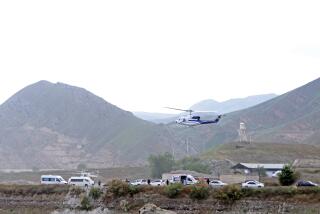85 Russians Said to Die in Copter
- Share via
MOSCOW — A mammoth Russian helicopter crashed into a minefield in strife-torn Chechnya on Monday, reportedly killing about 85 soldiers and giving this country a brutal reminder of the costs of a war that has been slipping from public view. Chechen rebels claimed they shot down the helicopter.
Reports from witnesses and Russian defense officials suggested that the MI-26 helicopter--dubbed the korova, or “cow,” by the military because of its size and shape--might have been hit by an antiaircraft rocket. However, there was no official confirmation, and both the number of casualties and the cause of the crash were unclear. The Interfax news agency said this morning that as many as 100 soldiers may have been killed.
The Itar-Tass news agency reported that witnesses spotted a missile trail before the helicopter crashed. The State Civil Aviation Service and prosecutors investigating the crash said the cause was a missile or a fire. Russian President Vladimir V. Putin named a top military commission to carry out an urgent investigation.
The chopper, jammed with soldiers, was approaching Russian military headquarters at Khankala, near the Chechen capital, Grozny, after flying from the Mozdok base northwest of the breakaway region when it went down.
The pilot reported a fire in one engine, requested permission for an emergency landing and managed to avoid houses. However, the helicopter crash-landed in a minefield just 300 yards from the runway, complicating the rescue efforts. Sappers had to go in to clear mines before rescue workers could reach the crash site.
Russian officials initially said there were 117 people on the helicopter, which can carry more than 100 troops plus armored vehicles. The estimate of the number on board then crept up to 142, including three civilians. Military sources reported that 80 to 85 people had died and that 32 had survived. That left the possibility that the death toll could rise.
A report on state-owned ORT television suggested that there were more survivors initially but that some men were killed by mines as they struggled to escape the wreckage. The mines were planted by the Russian military to protect the base from the Chechen rebels.
Within hours of the crash, a Web site used by the rebels claimed it was the result of a carefully planned attack.
“One of the mobile groups, part of a special antiaircraft unit of the Chechen forces, which was following the routes of transportation of units of occupiers, succeeded in destroying an enemy helicopter, causing significant loss of life among the enemy,” said an urgent announcement on the site. The rebels have claimed success at shooting down planes and helicopters in Chechnya in the past, but some of their claimed hits, denied by Russians, may have been simple air crashes.
If the rebel claim proves true, the death toll could surpass the most deadly attack on Russians in the current conflict. In February 2000, 84 Russian paratroopers were killed in a battle with rebels. Most of them were from the northwestern Russian city of Pskov.
Regardless, the loss of life will once again focus Russian attention on a conflict that has faded from public consciousness but still claims hundreds of lives a year.
Chechen separatist fighters are outgunned by Russian forces but have never been defeated. Waging a guerrilla war, they exact a steady toll of Russian casualties.
Hours after the crash, smoke still rose above the high grass in the field where the helicopter was burning. Reporters were not allowed within 300 yards of the site.
Russian forces entered the breakaway region in the Caucasus in 1994, suffered heavy casualties and withdrew defeated in 1996. When Putin became prime minister in 1999, he gained popularity with a gruff pledge to exterminate the rebels. His effort to regain control of Chechnya became the centerpiece of his successful presidential campaign in 2000.
By early 2000, Russia controlled most of Chechnya, but rebel commanders continued to mount tough guerrilla operations. Russia’s response has been to round up Chechen men, hundreds of whom have disappeared.
At a distance, the MI-26 appears similar to any other helicopter. However, as it approaches, its size becomes apparent. It looms about 26 feet high and 110 feet long. Soldiers can enter the cavernous interior via a large rear hatch, which gapes open to admit tanks, military trucks and jeeps.
There have been at least seven helicopter crashes in Chechnya since the second war began in 1999, some as a result of rebel missiles. Last September, two Russian generals and 11 soldiers died when Chechens shot down their copter.
Alexander I. Zhilin, defense analyst at the Moscow News weekly, said continuing rebel acts in Chechnya expose the Russians’ weakness in military intelligence.
The conflict “will continue indefinitely if the Kremlin doesn’t change its tactics in Chechnya and if it doesn’t make it a priority to carefully and painstakingly build up a network of special services agents in Chechnya which could gather information in time to prevent acts of terror,” he said.
But Zhilin added that the Russians have no choice but to remain in Chechnya.
“This is the most difficult time of the war now, but there is no way back,” he said. “It is clear that whatever the setbacks, the Kremlin just can’t withdraw its military forces from Chechnya. This will very quickly plunge all of Chechnya into banditry and lawlessness.”
More to Read
Sign up for Essential California
The most important California stories and recommendations in your inbox every morning.
You may occasionally receive promotional content from the Los Angeles Times.











